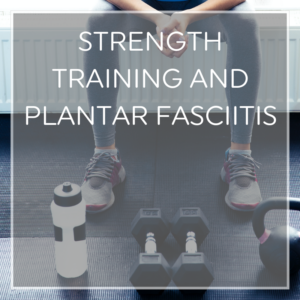 Most people who take part in strength training programs like Crossfit or BodyPump are typically very dedicated to health and fitness.
Most people who take part in strength training programs like Crossfit or BodyPump are typically very dedicated to health and fitness.
And while high-impact strength training can have incredible cardiovascular and muscle-building benefits, they can be extremely hard on the joints, fascia, and ligaments in the hands, arms, legs, and feet.
If you love staying fit with strength training — but wonder if you should worry about heel or arch pain, keep reading!
Plantar Fasciitis and Strength Training
While it’s true that strength training can put a lot of strain and impact on different muscle groups, ligaments and fascia (including the plantar fascia in the foot!) a lot of the outcome depends on your unique body, the exercises you participate in, and how well you care for your body when you’re not strength training (e.g., through a proper warmup and cool down good nutrition, and adequate rest between workouts).
While there are plenty of athletes who do suffer from plantar fasciitis as a result of strength training, there’s also some evidence that strength training programs can actually help improve plantar fasciitis, like this report from the Scandinavian Journal of Medicine and Science in Sports. The study followed participants who wore orthotic inserts and performed mild stretching daily, versus participants who wore orthotic inserts and engaged in high-load strength training daily. At the end of the study, the participants who engaged in strength training reported better function and pain levels.
Can Programs Like Crossfit Cause Plantar Fasciitis?

There’s no straightforward answer here: Many individuals who regularly enjoy Crossfit or BodyPump will maintain healthy arches and pain-free heels. Depending on the type of program and the types of exercises, some people may even enjoy protection from and improvement of heel pain or arch pain!
However, most types of strength training can still pose some risk of plantar fasciitis and heel pain. Specific high-impact exercises or routines that place a lot of strain and force on the arch of the foot through running, jumping, and lifting weights, strength training can be risk factors for heel pain.
Remember: Any high-impact activity, including jogging, basketball, or even standing in place for long periods of time can increase your risk for plantar fasciitis. The important thing is to take heel pain seriously, treat it quickly with effective remedies, and approach strength training in such a way that your heels and arches stay healthy!
Strength Training Safely for Plantar Fasciitis
If you love strength training, there are plenty of ways you can enjoy your passion safely–even if you have plantar fasciitis! This strength training protocol, originally developed by Dr. Rathleff, can be incorporated into your routine to help protect against plantar fasciitis or improve existing heel pain.
If you do notice heel pain while strength training, listen to your body. Take a break from the specific exercises or activities that aggravate the pain, and use the simple, inexpensive treatments below to give your arches extra support and cushioning.
If you’re taking a group fitness class like Crossfit, let your instructor know what’s going on. He or she can help you make modifications for very high-impact exercises that do not include a lot of jumping or strain on the heels, arches, or feet.
Are There Any Exercises I Should Avoid?

Again, the answer to this question depends a great deal on the health and strength of your feet and heels. If you’re new to strength training, acclimate to working out slowly, and allow yourself a couple days of rest between workouts to avoid degeneration and micro-injuries that may cause pain and lead to plantar fasciitis.
If you are experiencing heel pain while you strength train, you may want to avoid plyometric exercises (where both of your feet leave the ground) until you’re fully recovered. These exercises can include full-jacks and hal- jacks, long jumps, squat jumps, froggy jumps, jumping side lunges, jogging in place or running sprints across the room, and jumping rope.
In general, if your symptoms are mild, it’s okay to continue lifting weights, participating in low-impact exercises, and continuing exercises that strengthen the legs, feet, and ankles. Make sure you support your plantar fascia with orthotic inserts and use the treatments below to manage and treat your heel pain. When in doubt, see a doctor, especially if your pain is severe and you suspect you may have sustained a fracture or tear.
Treating Heel Pain from Strength Training
For most people, rest is a good first-line defense against heel pain from strength training. If particular activities seem to make your heel pain worse, avoid them until you feel better, then continue paying attention to how your body feels as you run, jump, or lift weights.
Icing, NSAIDs like Ibuprofen, and Tylenol can help bring down inflammation and manage pain flare-ups while taping and compression socks can help reduce swelling and improve blood flow while you exercise. Remember to warm up and cool down properly with stretches that strengthen and improve flexibility in your arch, calves, toes, and ankles.
To help your arch absorb extra impact and weight while you strength train, slip Heel Seats (an orthotic insert proven twice as effective as Dr. Scholls) into your favorite pair of supportive athletic shoes.
As you listen to your body, respond to heel pain quickly, and approach strength training safely, you can enjoy all the health benefits you set out for–including healthy feet, heels, and arches!




I have very bad heel pain on my left foot and the pain runs up and down my calf. I try to walk and ice afterwards, I cannot handle needles from the foot doctor and I take celebrex. I keep a bottle of ice water which I roll my foot on all through the day and night. I wear compression stockings and wedge heels. I diet yet I am still in pain. Any suggestions short of cutting off my foot.
I have the same issues for 5 months now. It would be nice to get some ideas other then in the article.